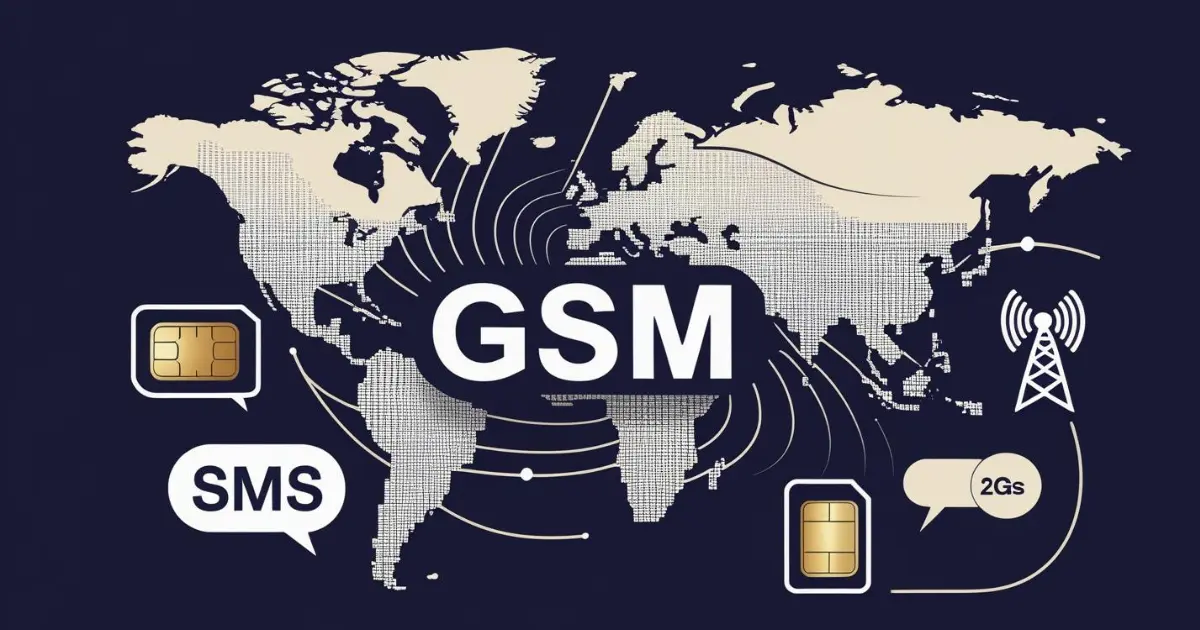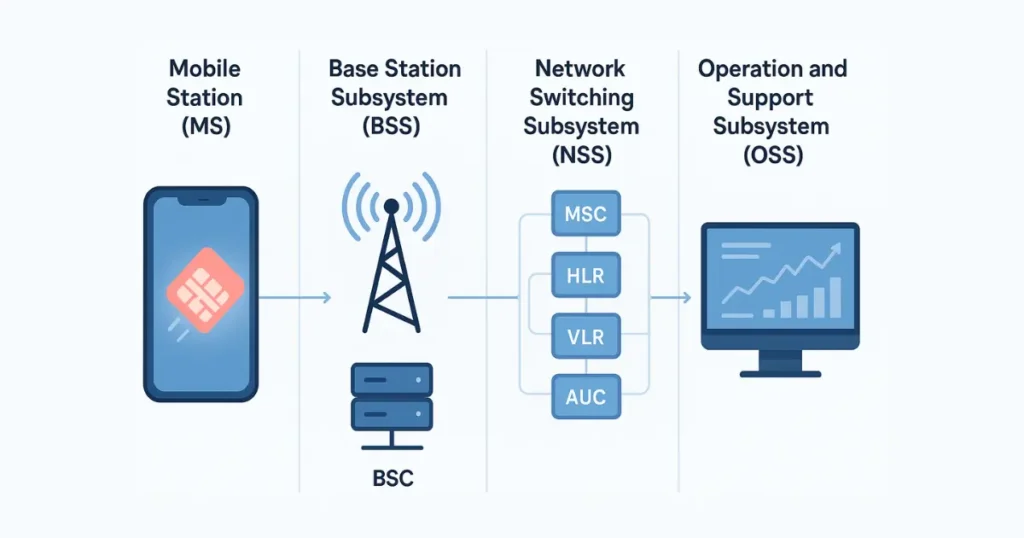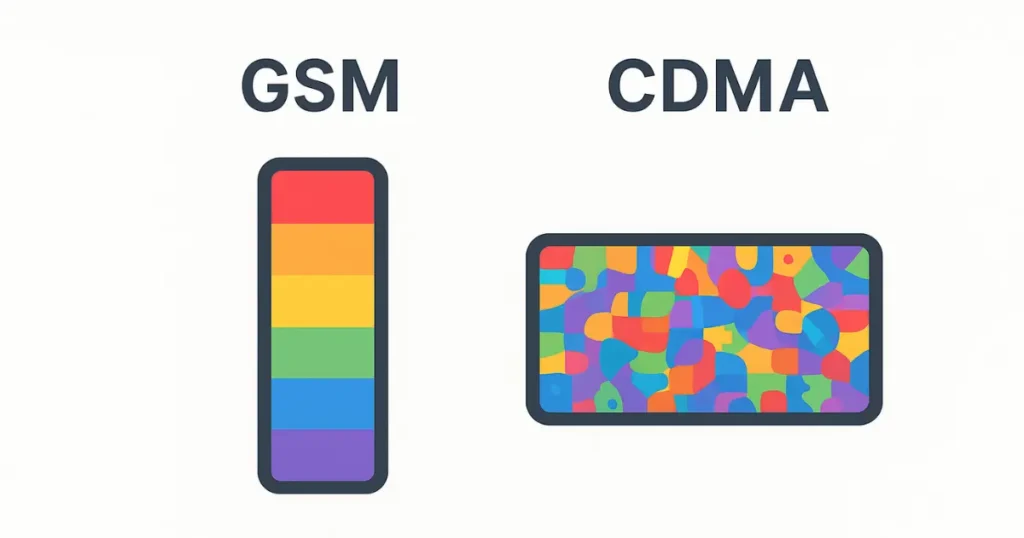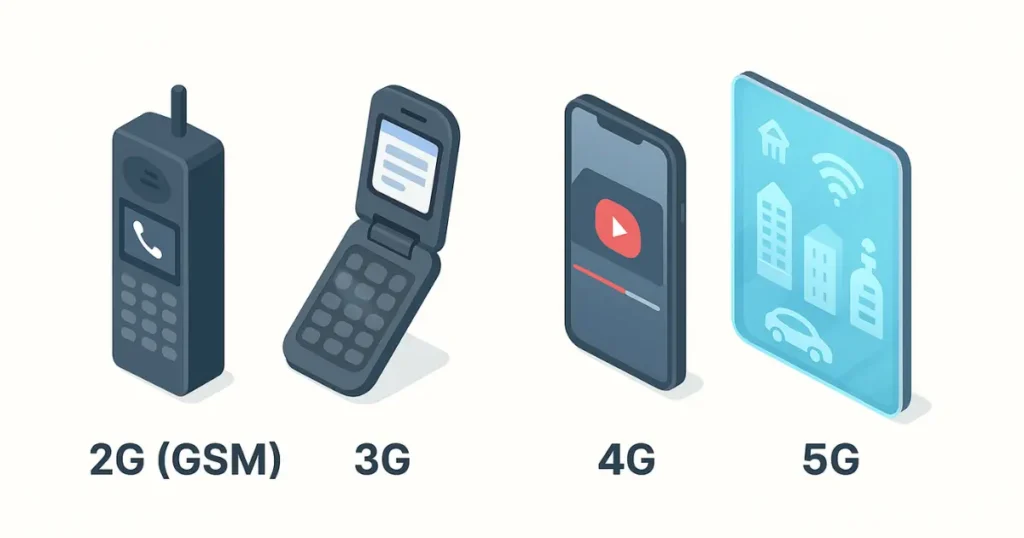
Have you ever wondered what GSM is and why it became the backbone of mobile communication? Before its arrival, countries relied on different analog systems that could not connect with each other, making international calls and roaming a huge challenge. GSM technology changed this forever by creating a single global mobile communication standard that allowed networks and devices to work seamlessly across borders.
In simple words, GSM (Global System for Mobile Communications) is the digital standard that made it possible for billions of people worldwide to make calls, send SMS, and use basic mobile data services with reliability and security. By replacing fragmented analog systems with one unified approach, GSM opened the doors to truly global mobile connectivity.
ADVERTISEMENT
GSM works by dividing available radio frequencies into smaller channels, making it possible for many users to share the same spectrum. This is done using Frequency Division Multiple Access (FDMA), where each channel is separated to prevent overlap and interference.
In GSM, each frequency channel is divided using Time Division Multiple Access (TDMA), where the channel is split into time slots, and every user is allocated a specific slot. By doing so, multiple conversations can occur simultaneously without disrupting one another.
When a call is made, the user’s voice is first converted into digital signals. These signals are compressed and transmitted in small packets during the assigned time slots. At the receiver’s side, the system puts the packets back together to reconstruct the original voice signal.
As users travel across different cell zones, GSM handles the handover smoothly. The network shifts the call to the nearest base station, maintaining continuous connectivity.
GSM also includes encryption algorithms to secure conversations and prevent unauthorized access. Beyond voice, it supports SMS and packet data services like GPRS and EDGE, enabling text messaging and mobile internet access.
ADVERTISEMENT

The Mobile Station consists of the mobile device and the SIM card. The device enables communication with the network, while the SIM card stores subscriber identity, authentication keys, and service information, allowing portability across devices.
The BSS manages radio communication between mobile devices and the network. It includes the Base Transceiver Station (BTS), which handles signals with users, and the Base Station Controller (BSC), which manages multiple BTS units and controls resource allocation.
The NSS is the central part of GSM, responsible for call switching, mobility management, and subscriber databases. This system is made up of the Mobile Switching Center (MSC), Home Location Register (HLR), Visitor Location Register (VLR), and the Authentication Center (AUC).
OSS ensures the network operates efficiently by handling monitoring, management, and maintenance. It provides operators with tools to oversee performance, detect faults, and optimize network resources.
Together, these subsystems create a modular and scalable GSM architecture. This design allows operators to expand coverage, increase capacity, and maintain seamless services for millions of users, ensuring reliability and efficiency in communication.
ADVERTISEMENT
One of GSM’s strongest features is global roaming support. Because it was adopted almost worldwide, users could travel across countries and still use their phones without compatibility issues, making it truly international.
GSM introduced the Subscriber Identity Module (SIM) card, which separated user identity from the device. This gave users flexibility to switch phones easily while keeping their number, contacts, and network profile intact.
Apart from voice calls, GSM made Short Message Service (SMS) a standard feature. SMS quickly became one of the most popular communication tools, allowing users to send short, instant text messages at low cost.
With enhancements like GPRS and EDGE, GSM supported mobile internet and multimedia messaging (MMS). Though slower compared to modern standards, these upgrades laid the foundation for data-driven mobile services.
GSM included encryption and authentication mechanisms to protect communication from interception. Combined with its wide coverage and efficient network design, GSM provided reliable, secure, and consistent connectivity worldwide.
ADVERTISEMENT
The idea of GSM originated in the early 1980s when Europe was dealing with a fragmented mobile landscape. At that time, different countries were using their own analog systems, which were often incompatible with one another. This lack of standardization made international communication and roaming very difficult.
To solve this problem, the Conference of European Postal and Telecommunications Administrations (CEPT) began working on a common digital standard that could unify mobile communication across Europe. Their efforts aimed to create a reliable system that would work seamlessly across borders and networks.
Later, the responsibility of developing and finalizing this standard was taken over by the European Telecommunications Standards Institute (ETSI). Through detailed planning and collaboration, they established the technical foundation of what became GSM. By 1987, the GSM standard was officially completed and ready for implementation.
In 1991, the first commercial GSM call was made in Finland, marking a historic moment in the shift from analog to digital communication. GSM quickly proved its advantages with clearer voice quality, higher network capacity, and stronger security. Its success in Europe spread rapidly across the world, making GSM the global standard for mobile communication.
ADVERTISEMENT

GSM uses a combination of FDMA and TDMA, where frequencies are divided into channels and further split into time slots for multiple users. CDMA, on the other hand, assigns unique codes to each user, allowing all to share the same frequency simultaneously.
In GSM, a SIM card stores user identity and authentication, making it easy to switch between devices. CDMA traditionally tied a user’s number to the handset itself, which made changing phones less convenient unless reprogrammed by the operator.
CDMA generally offered better spectral efficiency and capacity in certain conditions, making it effective in densely populated areas. However, GSM’s structured approach provided more predictable performance and was easier to deploy globally.
GSM became the worldwide standard, adopted in over 200 countries. CDMA, meanwhile, was more regionally concentrated, especially in the United States and parts of Asia, which limited its international roaming capabilities.
Thanks to SIM-based identity, GSM gave users greater flexibility and freedom in choosing devices and networks. CDMA networks were more restrictive, giving operators tighter control but limiting user options

As a 2G technology, GSM was chiefly developed to deliver voice calling and text messaging services. While it later introduced limited data services with GPRS and EDGE, its core focus remained on basic communication rather than high-speed internet.
3G networks expanded beyond GSM’s capabilities by offering faster data speeds and supporting services like video calls, email, and mobile web browsing. This marked the beginning of a more data-driven mobile experience compared to GSM’s voice-first approach.
With the introduction of 4G, mobile communication moved to broadband-level speeds, enabling HD streaming, social media, and mobile gaming. Unlike GSM, 4G was designed primarily for internet services, making it a leap toward the smartphone era.
5G advances even further, offering ultra-high speeds, minimal latency, and extensive connectivity to power IoT devices. While GSM connected people through calls and texts, 5G connects devices, industries, and smart systems in real time.
The key difference is that GSM was voice-centric, whereas 3G, 4G, and 5G are data-centric. GSM laid the foundation, but modern networks focus on internet-based services, applications, and high-bandwidth usage, far beyond what GSM was built to handle.
ADVERTISEMENT
The most basic and widespread use of GSM is voice calling. It enabled billions of people to stay connected across cities, countries, and continents, providing affordable and reliable mobile telephony worldwide.
GSM introduced Short Message Service (SMS), which became a cultural phenomenon. From personal texts to banking alerts and verification codes, SMS is still widely used because of its simplicity and reliability.
GSM evolved with technologies like GPRS and EDGE, enabling users to experience the initial stages of mobile internet. Users could browse websites, send emails, and use multimedia messaging (MMS), paving the way for more advanced mobile data services in 3G and beyond.
GSM has also been used in IoT and M2M applications, such as vehicle tracking, smart meters, and remote sensors. Its wide coverage and low cost make it suitable for devices that need basic, low-bandwidth connectivity.
In many developing regions, GSM remains the backbone for emergency services and rural communication. Its extensive coverage ensures that even in remote areas, people can access mobile connectivity for essential needs.
As 4G and 5G expand, GSM is being gradually phased out in many developed countries. Operators are reallocating spectrum once used for GSM to newer technologies that offer higher speeds and efficiency.
Despite its decline elsewhere, GSM still plays a vital role in developing countries. Its affordability and wide coverage make it essential for people who rely on basic voice and SMS services.
GSM may continue to survive through low-power IoT devices. Applications like smart meters, trackers, and rural sensors benefit from GSM’s simple and reliable connectivity without needing high-speed data.
Some governments and operators may retain GSM as an emergency fallback network. Its robust and proven infrastructure ensures communication continuity when modern networks fail or during disasters.
ADVERTISEMENT
Technology: GSM uses FDMA & TDMA (frequency and time slots). CDMA uses unique codes on one frequency.
SIM Card: GSM uses removable SIM cards. CDMA traditionally tied the number to the phone.
Yes, but declining.
Still vital in many developing regions for basic service.
Being phased out in developed countries to free up spectrum for 4G/5G.
User Freedom: Separated user identity from the device.
Easy Switching: Allowed users to change phones easily.
Global Roaming: Made international network compatibility simple.
No. A phone that is only a GSM (2G) phone cannot connect to newer networks.
Most modern phones are multi-band and support GSM in addition to 3G/4G/5G for backward compatibility.
ADVERTISEMENT